Why choose a stainless-steel kitchen sink?
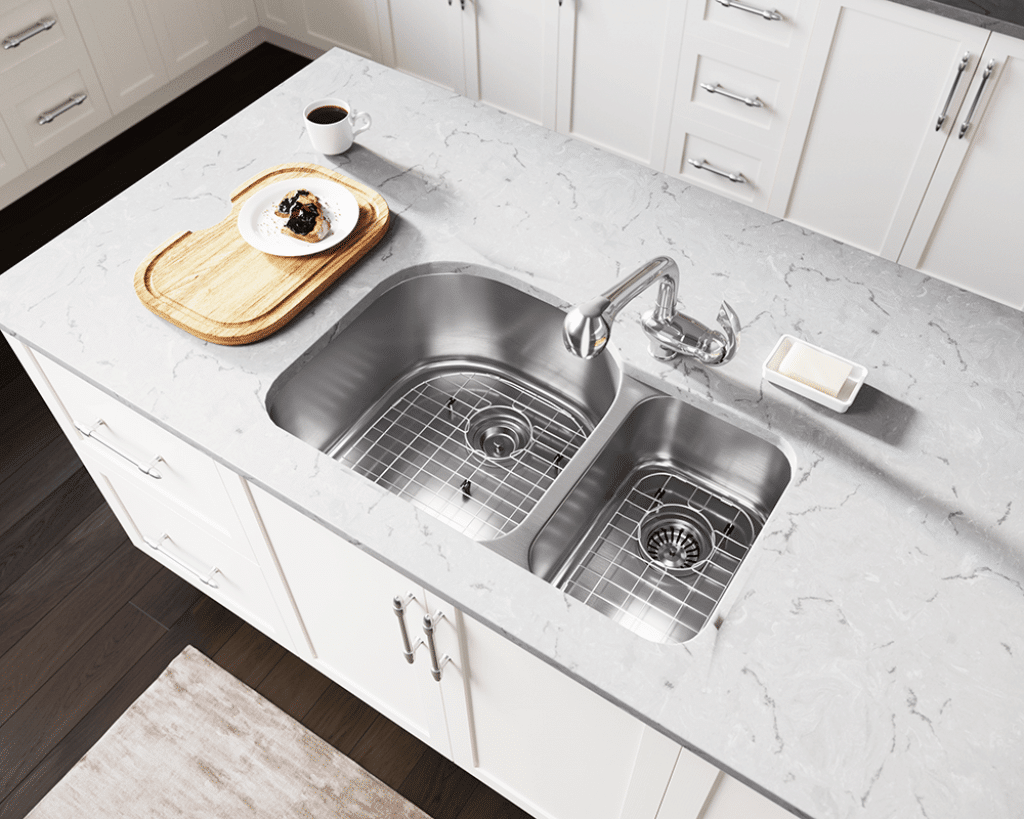 A stainless-steel kitchen sink is one of the most popular choices, and this is all to do with their main properties including heat and stain resistant functions. They are also the type most likely to be offered in a variety of different sizes, styles, and models. Lighter in weight than many other choices, a stainless style kitchen sink is also one of the easier of products to fit, which perhaps explains why so many homeowners tend to buy these with the idea of installing them by themselves, even if they have not only a faucet, but also an instant hot water dispenser or a filter to be added on. This makes them the cheaper of options as they don’t require professional help to get them up and running. When they are installed, they are one of the more functional of models, especially when you select those with lower gauges.
A stainless-steel kitchen sink is one of the most popular choices, and this is all to do with their main properties including heat and stain resistant functions. They are also the type most likely to be offered in a variety of different sizes, styles, and models. Lighter in weight than many other choices, a stainless style kitchen sink is also one of the easier of products to fit, which perhaps explains why so many homeowners tend to buy these with the idea of installing them by themselves, even if they have not only a faucet, but also an instant hot water dispenser or a filter to be added on. This makes them the cheaper of options as they don’t require professional help to get them up and running. When they are installed, they are one of the more functional of models, especially when you select those with lower gauges.
Features to consider while choosing a kitchen sink
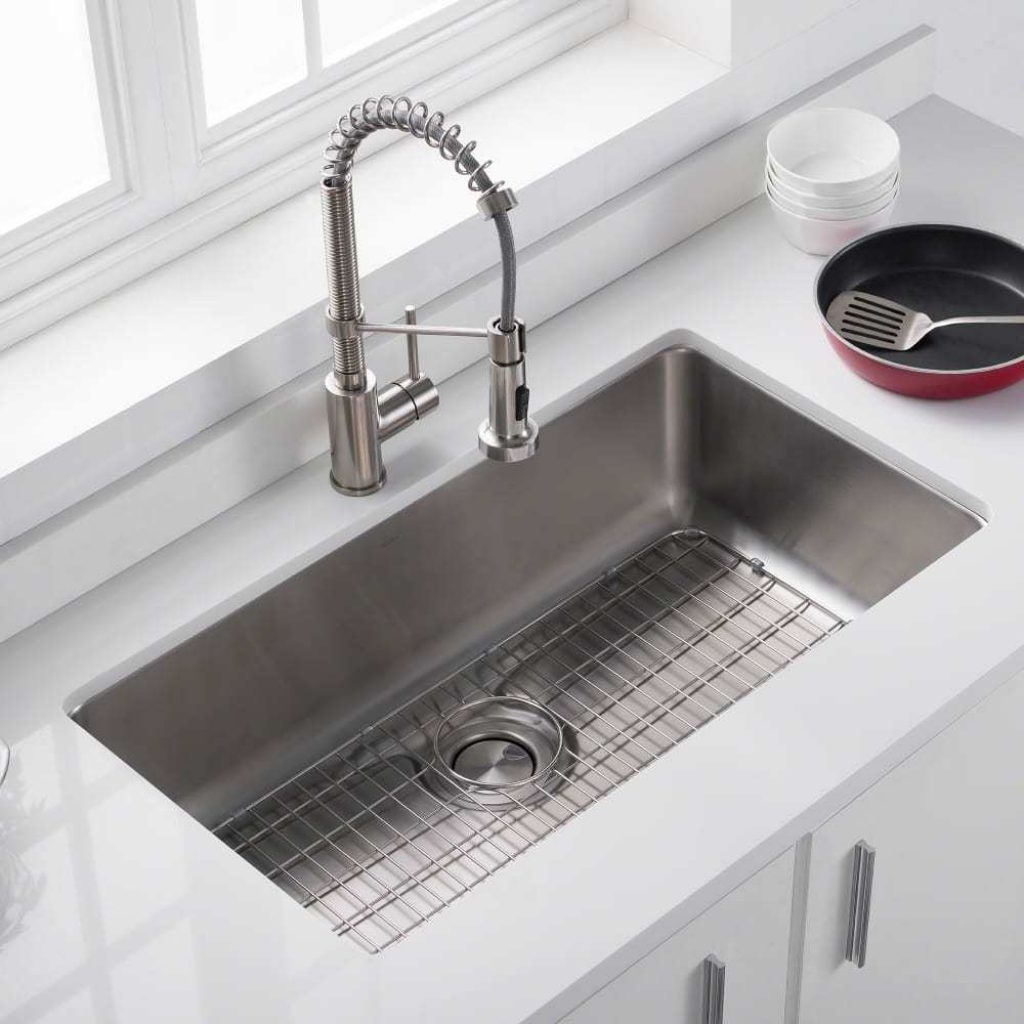 We believe that there are several essential features that you should be looking for when deciding on that best stainless-steel kitchen sink for your individual needs. Each particular sink type will offer something slightly different from that of its competitors, with some models providing one or two additional features as standard. However, though a sink with many varied features may sound a great purchase, you will need to ensure that your chosen model offers everything that you need and features that you are more likely to use once your sink has been installed in your own home. All our reviewed stainless-steel kitchen sinks have been chosen as those models we believe to offer you the most practical and necessary of features that you need in such a product, and here we explain them a little further.
We believe that there are several essential features that you should be looking for when deciding on that best stainless-steel kitchen sink for your individual needs. Each particular sink type will offer something slightly different from that of its competitors, with some models providing one or two additional features as standard. However, though a sink with many varied features may sound a great purchase, you will need to ensure that your chosen model offers everything that you need and features that you are more likely to use once your sink has been installed in your own home. All our reviewed stainless-steel kitchen sinks have been chosen as those models we believe to offer you the most practical and necessary of features that you need in such a product, and here we explain them a little further.
Sink type
There is a range of sink types which you can select from, which we have included in our review. These vary greatly, but the main two are a top mount sink, which is also referred to by some as a drop-in sink, and an undermount sink, which can be directly installed underneath your countertop. You will also find farmhouse sinks, which are also known as apron sinks and extend slightly over the edge of your counter. Then there is the bar sink type, such as the Ruvati RVM4136, which are generally the smaller and shallower than an average standard kitchen sink.
You may prefer a specific kind of sink for its visual look, or you may want a particular type for its practicality. Additionally, your sink type may be dependent on the room you have available to install such a product as well.
Number of bowls
 This may be more of a personal preference, but it is possible to have more than one bowl in your sink type if you prefer, with the Kraus Standart PRO KHU103-33 and the Ruvati RVM4350 being evidence of this. Most sinks have just the one bowl, and if it’s a large enough bowl, such as the ones reviewed here, you can place many items in it all in the one go. However, some people prefer the practicality of two bowls in their sink as it means you can wash in one and prepare and clean food in the other.
This may be more of a personal preference, but it is possible to have more than one bowl in your sink type if you prefer, with the Kraus Standart PRO KHU103-33 and the Ruvati RVM4350 being evidence of this. Most sinks have just the one bowl, and if it’s a large enough bowl, such as the ones reviewed here, you can place many items in it all in the one go. However, some people prefer the practicality of two bowls in their sink as it means you can wash in one and prepare and clean food in the other.
Dimensions and cabinet size
Before you select your preferred stainless-steel model, take a look at the outer sink dimensions and the minimum cabinet size that is needed for that perfect fit. Most sinks are standard sizes and will fit immediately as a replacement, but if you are installing a sink for the first time, you will need to ensure the hole is big enough to accommodate your model. Each sink, such as these reviewed, should ideally come with mounting hardware and a cutout template which allows you to work to scale during the fitting process.
Drain size
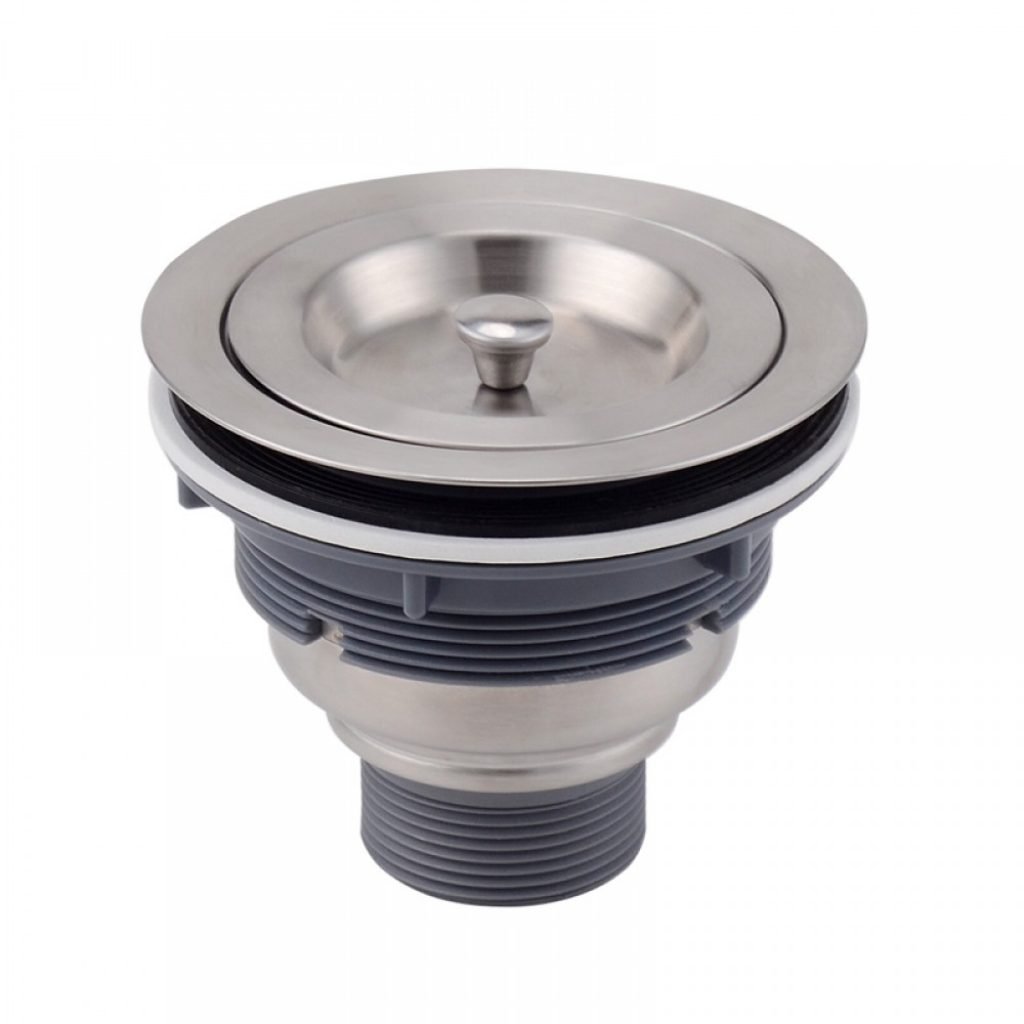 The standard sizes of most drain size openings are 3.5 inches, and all of these reviewed models offer this in their sinks. Just like the importance of getting the dimensions and cabinet sizes right beforehand, you should also ensure that your drain size is a perfect fit with that of your sink and is positioned to attach directly to your sink upon installation. This is important to ensure that the water from your sink can flow freely and drain away correctly, without causing any build up or blockage, which will in time lead to the sink becoming damaged if not corrected.
The standard sizes of most drain size openings are 3.5 inches, and all of these reviewed models offer this in their sinks. Just like the importance of getting the dimensions and cabinet sizes right beforehand, you should also ensure that your drain size is a perfect fit with that of your sink and is positioned to attach directly to your sink upon installation. This is important to ensure that the water from your sink can flow freely and drain away correctly, without causing any build up or blockage, which will in time lead to the sink becoming damaged if not corrected.
Gauge
The lower the gauge number, the thicker the stainless steel used in your skin will be. Thinner stainless steel has a higher gauge number. Look for the best number you can here, around the 16 gauge, like those all reviewed here. However, we have also included the HausinLuck Drop-in Kitchen Sink as just one of the models with an 18 gauge. Generally, the thicker the steel used, the more expensive the product is.
However, if you want a model which is more durable and can cope with more extended daily wear and tear, try to aim for 16 gauge or less here.
Finish
The finish of a stainless-steel sink should ideally be a satin finish. This is a somewhat lustrous type of finish, but the idea here is that it will enable a better layer of patina to develop over time than that of a sink with a matte finish. Therefore, you will be reassured of a sink finishing which works harder to prevent corrosion and resist staining over its many years of use. As you can see from the sinks reviewed above, we recommend those with a brushed satin or commercial grade satin finish for optimal results here.
Warranty
Lastly, with the higher price tag on stainless steel sinks, you may want to select a model which offers a decent warranty. This can mean that should something happen and your sink needs repairing or even replacing, you won’t spend as much money at this stage if you are covered under warranty. Look for those sinks which offer a limited lifetime for the best guarantees.
How to install a kitchen sink?
 When you install any new kitchen sink, you should always refer to the manufacturer’s instructions before beginning. Make sure that you have the correct dimensions covered so that your sink fits neatly and correctly and lines up with your drain. Use the cutout template included with your product to ensure this before you start and remember to turn off your water supply before you begin. All of these products reviewed here are the easier of sinks to install and all come with adequate instructions to guide you through this process, meaning no additional outside professional help is needed.
When you install any new kitchen sink, you should always refer to the manufacturer’s instructions before beginning. Make sure that you have the correct dimensions covered so that your sink fits neatly and correctly and lines up with your drain. Use the cutout template included with your product to ensure this before you start and remember to turn off your water supply before you begin. All of these products reviewed here are the easier of sinks to install and all come with adequate instructions to guide you through this process, meaning no additional outside professional help is needed.
Cleaning tips
 A stainless-steel sink is simple to clean and, if done correctly and regularly, can preserve its original shiny look for many years to come! These are some tips to encourage a cleaner and healthier looking sink every time:
A stainless-steel sink is simple to clean and, if done correctly and regularly, can preserve its original shiny look for many years to come! These are some tips to encourage a cleaner and healthier looking sink every time:
- Rinse your sink with water after every use to rid of all soap and detergent used
- Using a non-abrasive soft cleaner scrub in the direction of your sinks polish lines
- Finally, wipe the surface area dry with clean, dry towels, therefore preventing any water spots occurring. Regular drying of a stainless-steel sink will ensure that no rust spots arise
- Once a week or month, give your sink a well-deserved thorough clean using baking powder and a soft cloth, therefore encouraging a beautiful shine

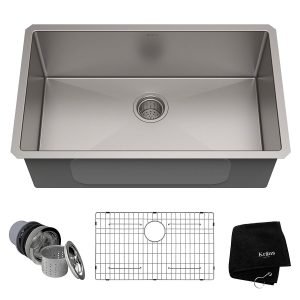
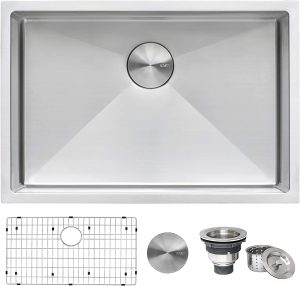
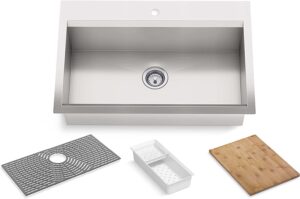
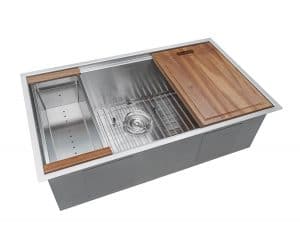
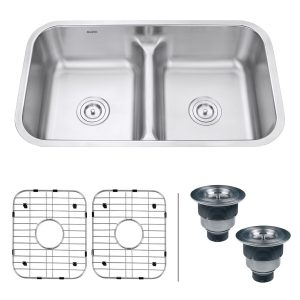

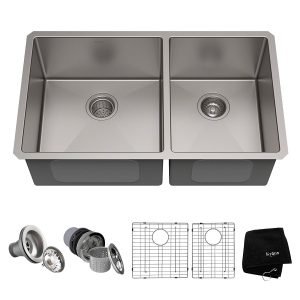
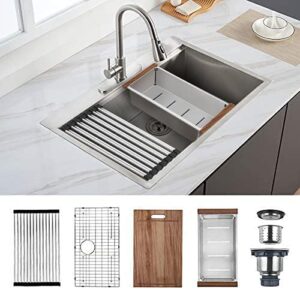
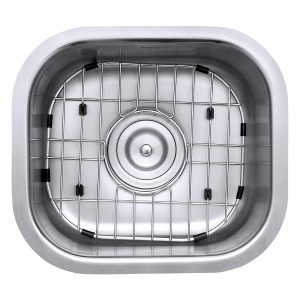
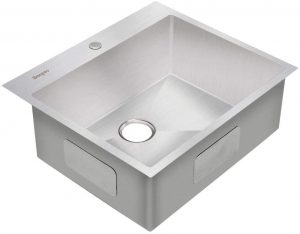
 A stainless-steel kitchen sink is one of the most popular choices, and this is all to do with their main properties including heat and stain resistant functions. They are also the type most likely to be offered in a variety of different sizes, styles, and models. Lighter in weight than many other choices, a stainless style kitchen sink is also one of the easier of products to fit, which perhaps explains why so many homeowners tend to buy these with the idea of installing them by themselves, even if they have not only a faucet, but also an
A stainless-steel kitchen sink is one of the most popular choices, and this is all to do with their main properties including heat and stain resistant functions. They are also the type most likely to be offered in a variety of different sizes, styles, and models. Lighter in weight than many other choices, a stainless style kitchen sink is also one of the easier of products to fit, which perhaps explains why so many homeowners tend to buy these with the idea of installing them by themselves, even if they have not only a faucet, but also an  We believe that there are several essential features that you should be looking for when deciding on that best stainless-steel kitchen sink for your individual needs. Each particular sink type will offer something slightly different from that of its competitors, with some models providing one or two additional features as standard. However, though a sink with many varied features may sound a great purchase, you will need to ensure that your chosen model offers everything that you need and features that you are more likely to use once your sink has been installed in your own home. All our reviewed stainless-steel kitchen sinks have been chosen as those models we believe to offer you the most practical and necessary of features that you need in such a product, and here we explain them a little further.
We believe that there are several essential features that you should be looking for when deciding on that best stainless-steel kitchen sink for your individual needs. Each particular sink type will offer something slightly different from that of its competitors, with some models providing one or two additional features as standard. However, though a sink with many varied features may sound a great purchase, you will need to ensure that your chosen model offers everything that you need and features that you are more likely to use once your sink has been installed in your own home. All our reviewed stainless-steel kitchen sinks have been chosen as those models we believe to offer you the most practical and necessary of features that you need in such a product, and here we explain them a little further. This may be more of a personal preference, but it is possible to have more than one bowl in your sink type if you prefer, with the
This may be more of a personal preference, but it is possible to have more than one bowl in your sink type if you prefer, with the  The standard sizes of most drain size openings are 3.5 inches, and all of these reviewed models offer this in their sinks. Just like the importance of getting the dimensions and cabinet sizes right beforehand, you should also ensure that your drain size is a perfect fit with that of your sink and is positioned to attach directly to your sink upon installation. This is important to ensure that the water from your sink can flow freely and drain away correctly, without causing any build up or blockage, which will in time lead to the sink becoming damaged if not corrected.
The standard sizes of most drain size openings are 3.5 inches, and all of these reviewed models offer this in their sinks. Just like the importance of getting the dimensions and cabinet sizes right beforehand, you should also ensure that your drain size is a perfect fit with that of your sink and is positioned to attach directly to your sink upon installation. This is important to ensure that the water from your sink can flow freely and drain away correctly, without causing any build up or blockage, which will in time lead to the sink becoming damaged if not corrected. When you install any new kitchen sink, you should always refer to the manufacturer’s instructions before beginning. Make sure that you have the correct dimensions covered so that your sink fits neatly and correctly and lines up with your drain. Use the cutout template included with your product to ensure this before you start and remember to turn off your water supply before you begin. All of these products reviewed here are the easier of sinks to install and all come with adequate instructions to guide you through this process, meaning no additional outside professional help is needed.
When you install any new kitchen sink, you should always refer to the manufacturer’s instructions before beginning. Make sure that you have the correct dimensions covered so that your sink fits neatly and correctly and lines up with your drain. Use the cutout template included with your product to ensure this before you start and remember to turn off your water supply before you begin. All of these products reviewed here are the easier of sinks to install and all come with adequate instructions to guide you through this process, meaning no additional outside professional help is needed. A stainless-steel sink is simple to clean and, if done correctly and regularly, can preserve its original shiny look for many years to come! These are some tips to encourage a cleaner and healthier looking sink every time:
A stainless-steel sink is simple to clean and, if done correctly and regularly, can preserve its original shiny look for many years to come! These are some tips to encourage a cleaner and healthier looking sink every time: